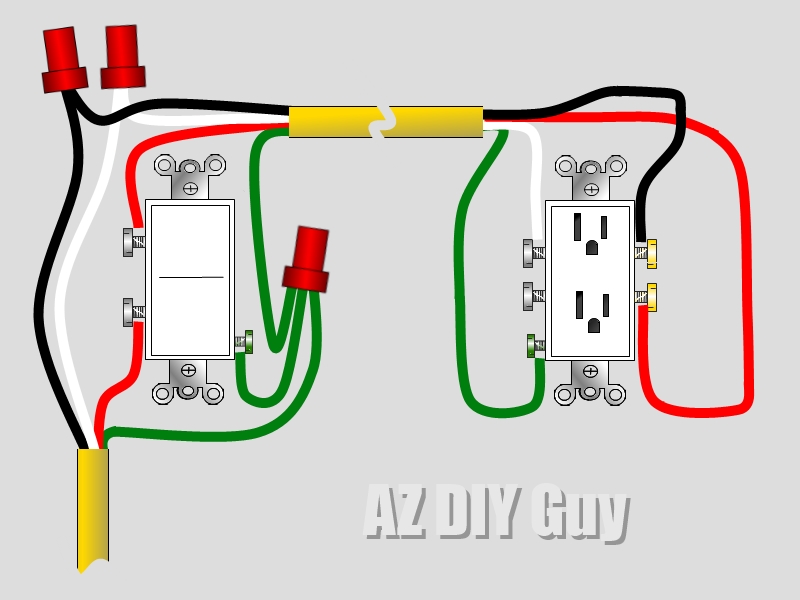Decoding the Mystery: Red, Black, and White Wires in Your Electrical Outlet
Ever peered into the back of an electrical outlet and felt a flicker of curiosity, maybe even a touch of apprehension, at the sight of those red, black, and white wires? It's a common experience. Most of us interact with electrical outlets daily without giving much thought to the intricate network behind them. But understanding the purpose of each wire, particularly in a red, black, and white configuration, can be crucial for both safety and functionality.
This isn't about becoming an electrician overnight. It's about demystifying a fundamental aspect of our homes and empowering ourselves with basic knowledge. We'll explore the role of each wire color, delve into common scenarios where you might encounter them, and discuss the importance of professional help when needed.
The typical residential electrical outlet configuration involves these three key players: black, white, and green (or bare copper) wires. The black wire is the "hot" wire, carrying the electrical current into the outlet. The white wire is the "neutral" wire, providing a return path for the current back to the electrical panel. The green or bare copper wire is the "ground" wire, offering a safe path for stray currents to prevent electrical shocks.
However, the presence of a red wire throws a slightly different dynamic into the mix. Red wires often signify a second "hot" wire, commonly found in 240-volt circuits used for appliances like electric ranges, dryers, or air conditioners. They can also indicate a separate circuit for switched outlets, allowing you to control lights or other devices from a wall switch.
So, what does it mean when you encounter an outlet wired with red, black, and white wires, specifically? This configuration is often associated with 240-volt circuits or multi-wire branch circuits. In a 240-volt circuit, both the red and black wires are "hot," each carrying 120 volts, which combine to deliver 240 volts. This higher voltage is necessary for appliances that demand more power. In a multi-wire branch circuit, the red wire might be connected to a separate 120-volt circuit, possibly controlled by a switch.
Historically, color coding for electrical wiring wasn't standardized. The adoption of specific colors for different functions came later, enhancing safety and simplifying electrical work. The contemporary standard helps electricians quickly identify the purpose of each wire, reducing the risk of misconnections and potential hazards.
Working with electricity requires caution and expertise. While understanding the basics of wiring can be empowering, tampering with electrical connections without proper training can lead to serious consequences, including electric shock, fire, and damage to appliances. If you're unsure about any aspect of your electrical system, consulting a qualified electrician is paramount.
Advantages and Disadvantages of Red, Black and White Wired Outlets
| Advantages | Disadvantages |
|---|---|
| Higher voltage for powerful appliances | Increased risk of shock if mishandled |
| Separate circuits for switched outlets | Complexity in troubleshooting |
Best Practices:
1. Always turn off the power at the breaker box before working on any electrical outlets.
2. Use a voltage tester to double-check that the power is off.
3. Use wire connectors appropriate for the wire gauge and type.
4. Securely tighten all connections to prevent loose wires.
5. If you're uncertain about any aspect of the wiring, consult a licensed electrician.
FAQ:
1. What does a red wire in an outlet mean? It typically signifies a second hot wire, often used for 240-volt appliances or switched circuits.
2. Is it safe to work on electrical outlets myself? Only if you have the necessary training and experience. Otherwise, consult a qualified electrician.
3. What should I do if I see a loose wire in an outlet? Turn off the power at the breaker and immediately contact an electrician.
4. Can I plug a 120-volt appliance into a 240-volt outlet? No, doing so will likely damage the appliance.
5. What's the purpose of the ground wire? It provides a safe path for stray currents to prevent electric shocks.
6. How can I tell if an outlet is 240 volts? It typically has a different slot configuration than a standard 120-volt outlet.
7. What should I do if an outlet feels hot to the touch? Turn off the power at the breaker and call an electrician.
8. Can I change the wiring in an outlet myself? It's recommended to hire a qualified electrician for any wiring modifications.
In conclusion, understanding the function of red, black, and white wires in your electrical outlets is a key step in ensuring both the safety and functionality of your home's electrical system. While this information provides a foundational understanding, remember that working with electricity can be hazardous. Don’t hesitate to reach out to a qualified electrician for any electrical work you're unsure about. Your safety and the proper functioning of your electrical system are paramount. By respecting the power of electricity and seeking professional help when needed, you can maintain a safe and efficient home environment.
Mastering the inverted smiley a guide to upside down smiley copy paste
Unlocking fm24 success mastering tactical foundations
Unlocking the secrets of the toyota tacoma wheel lug pattern












